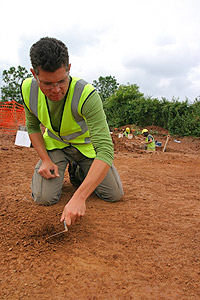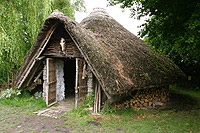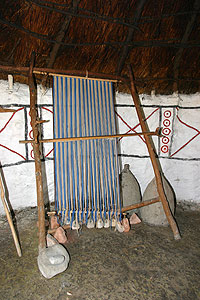
Archaeologists have discovered a 2,500 year old prehistoric farm near Huntworth, south of Bridgwater, Somerset. The remains of two Iron Age houses have been found, along with compounds and fields on an island of higher land.
The excavations were done in advance of the building of a new dairy and a cattle market by Mead Realisations. Katherine Wetherall said ‘as a farming family it is fascinating to think that over 2000 years, farmers could have been taking their cows down to lush low-lying pastures. Some things don’t change!’
Steve Membery of Somerset County Council’s archaeology team said ‘this is an important find for the history of Somerset. An Iron Age farm is an exciting discovery. It shows just how important it is to check sites before new developments. The first clue about the site came from air photographs. A geophysical survey and trial trenches helped us decide where excavations were needed.’
A good impression of what the houses at the site looked like comes from the nearby Peat Moors Centre at Westhay which is run by the Council. Three replica Iron Age houses have been built. Each house has a conical thatched roof and a big porch.

The month long excavation by junction 24 on the M5 finished at the end of June 2006. The work was done by Wessex Archaeology and Dr Andrew Fitzpatrick added ‘Somerset has some well-preserved Iron Age hillforts and the famous Glastonbury Lake Village, but only two farms have been excavated before. One was at Christon, near Winscombe. It was found in 1970 as the M5 was being built. Now sites are checked for archaeology before building starts.’
Somerset in the Iron Age

Iron Age Somerset is famous for it forts, the largest hillfort in Britain is at Ham Hill near Montacute and at Cadbury Castle by South Cadbury, the remains of the last stand by local tribesmen against the invading Romans were found. Well preserved forts are found on high ground all across the county.
Perhaps more important are the well-preserved villages at Glastonbury and Meare in the Somerset Levels. The Glastonbury village was built on an artificial island in a swamp and was only accessible by boat. Home to as many as 200 people, the village was eventually abandoned because of the rising water level and this has kept the remains waterlogged ever since. As a result much evidence that normally rots away on sites on dry land has been preserved. This makes the Lake Villages of European importance.
At sites such as Huntworth, the remains of broken Iron Age pots have been found but at Glastonbury as well as pots the remains of wooden tubs and wicker baskets have been preserved. Pieces of baked clay at Huntworth might be from weights used on looms to keep textiles taught. At Glastonbury pieces of wood thought to be from looms themselves have been found.
Other Iron Age farms on dry land include Canards Grave, Shepton Mallet, where the remains of four circular houses were found. This site was also excavated by Wessex Archaeology.
The people of Iron Age Somerset
Roman writers tell us the names of some of the tribes of Britain. By looking at the evidence from coins, archaeologists think that at the end of the Iron Age parts of Somerset may have been occupied by three different tribes. The tribes are known as the Durotriges, Dobunni and the Dumnonii. The Durotriges lived in Dorset and south-east Somerset, the Dobunni were in Gloucestershire and north-east Somerset and the Dumnonii lived from west Somerset into Devon and Cornwall.
